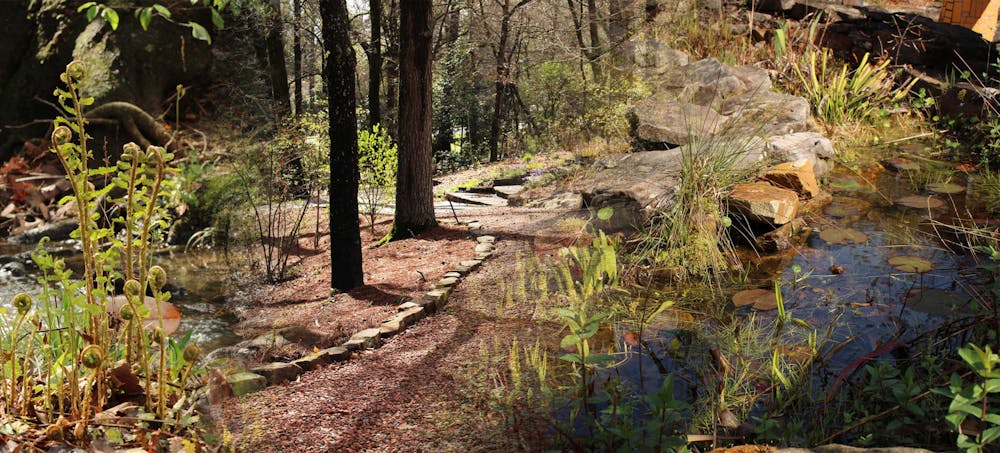During a drive down South College Street, one can spot the branches of the nearby trees reaching out toward the cemented road, and not far from the roadside bees buzz around nearby flowering bushes.
Auburn is home to a variety of native species with Alabama commonly ranked as the fourth-highest biodiverse state.
According to U.S. Fish & Wildlife Service’s Environmental Conservation Online System, Alabama is number three with the most endangered or threatened species listed. Additionally, Lee County holds about 37 species that are imperiled, or at risk, according to the Alabama Natural Heritage Program database. However, members of Auburn University and the City of Auburn are working to protect the biodiversity in the area.
Part of Auburn’s campus, Donald E. Davis Arboretum, is a collection of native plant species with its outreach and programs related to conservation efforts.
Morgan Pendergrass, director of the arboretum, said the arboretum is part of a larger network through the Alabama Plant Conservation Alliance where they work with gardens in other locations like Atlanta and Huntsville to further the conservation effort.
“It’s a lot of work that happens here, but then a lot of work happens out across the state with folks that are willing to go out and do it and be the boots on the ground that are taking care of trying to protect the species before they blink out,” Pendergrass said.
One of the arboretum’s functions through APCA is safeguarding, which is the holding of endangered plants to then propagate later on. They also are involved with species monitoring, which is hand-counting native plants in a particular area.
When it comes to the campus’ landscaping, Pendergrass said she believes the University does its best to make use of native species in the places it can. For instance, Pendergrass said outside of the Mell classrooms the University uses native grasses and, along with the rocks, and that section acts as a part of stormwater management, which can help reduce runoff pollution.
Another resource on campus is the Auburn University Museum of Natural History with part of its mission statement saying, it aims to “conduct biodiversity research, preserve and document our planet’s biodiversity,” per se its website.
Jonathan Armbruster, director of AUMNH, said every species is part of a service to the ecosystem and having high biodiversity is what keeps the ecosystem functioning.
“If you were interested in fishing, it’s not just the bass that are in the stream that are important,” he said. “It’s all things that they eat. And so you got to make sure that biodiversity remains high so that there’s a community there for the things that you’re interested in to survive.”
However, Armbruster said people can help protect aquatic species by decreasing water usage and being respectful of their habits by not leaving waste or trash behind. He said endangered species aren’t always in some far-off place. For example, he said there’s an endangered mussel that lives in Chewacla State Park.
Armbruster said good land practices also help with biodiversity as “development and biodiversity don’t have to be antagonistic towards each other.”
Christopher Lepczyk, professor of wildlife biology and conservation, said some good land practices could be what people do with their lawns. Having fewer barriers between lawns can help vegetation grow more consistently. Also, individuals not raking leaves in the fall can help put nutrients in the soil, and the decaying leaves will provide shelter for insects in the winter. It’s little practices by a group of people that can have an impact, he said.
“If we could imagine in a city block, you have 10 houses that are next to each other. If they all stop putting a lot of pesticides on their property and stop worrying about green lawns and all collectively decided to engage in positive activities for wildlife, that would have a really big effect on local biodiversity,” he said.
Lepczyk said that as more people live in urban areas, people tend to associate with less biodiversity. However, green spaces, like parks and cemeteries, can provide patches of biodiversity. The larger the area is and the more closely knit the areas are, the more likely higher biodiversity will occur, he said.
“The ability to tap those spaces on campus or across campus to the city is really important,” Lepczyk said. “So having the ability for organisms to move between locations, really promotes biodiversity. Rather than having isolated green spaces that are surrounded by urban developments with no greenery just makes it more difficult for plants and animals to move across the landscape to have gene flow to have their populations operate.”
Anne Randle, Urban Forestry Specialist at the City of Auburn, said Auburn’s canopy coverage is about 55%, which is fairly high with national averages being around 40 to 45%. Randle said this means the City has a focus on maintaining coverage.
As Auburn continues to develop, one of the ways this is done is through zone ordinances that require a certain amount of trees on a property. If the trees are already there and are able to be preserved throughout the construction process, that’s preferred, but if not, a certain amount of new trees will be planted in its place, Randle said.
Another part is favoring native species over invasive species. The City offers volunteer workdays that focus on removing invasive species in city parks and along bike trails.
“It’s really more of an education and outreach thing to get community members involved in taking ownership over our green space and taking ownership over the greater community ecosystem outside of their own backyards,” she said.
Randle said the City also does invasive species removal on their own city property as well. However, there is also an emphasis on planting native species where they can.
In 2018, they partnered with the Alabama Forestry Commission to document a heat map, which shows them where there is a high density of shade versus where there is not. Within the past year of 2021, the City has planned 235 native trees.
When it comes to planting native trees, Randle said a few factors need to be taken into account such as whether or not the tree can handle urban pollution, the heat that comes off of the city sidewalks during the summer and also the placement of powerlines and waterlines.
“We are not removed from the ecosystems we live in,” Randle said. “We are a part of it just as much as the fish and the birds and the trees and the soil, fungi and all those other parts. We like to think that we are removed from it, but we’re not. I think that it’s part of every person the community’s job to preserve that healthy ecosystem, to be active in it and to be responsible for it.”
Do you like this story? The Plainsman doesn't accept money from tuition or student fees, and we don't charge a subscription fee. But you can donate to support The Plainsman.

Abigail Murphy, senior in journalism with minors in history and women and gender studies, is the operations managing editor at The Auburn Plainsman.





